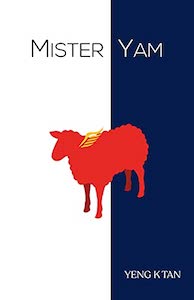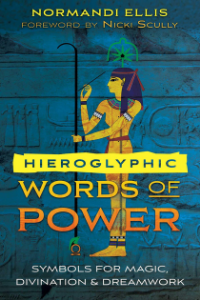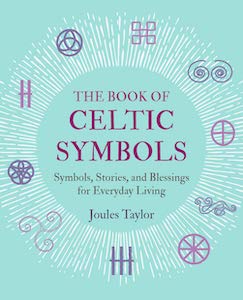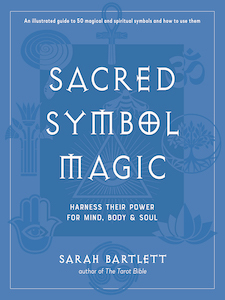
Sacred Symbol Magic: Harness Their Power for Mind, Body, and Soul, by Sarah Bartlett
Weiser Books, 9781578637386, 128 pages, April 2021
Working with any form of magic requires not only belief in what you are doing and why, but also harnessing the power of the corresponding energies to amplify and set out the pathway to the ultimate goal or intention. After all, if you just stick a photograph of a yin-yang symbol on the wall, it will not have any true meaning in the context of your need…unless you actually engage in the process of the magic itself.1
Sacred Symbol Magic: Harness Their Power for Mind, Body, and Soul, by Sarah Bartlett is a compact hardcover title that is dense with information and visual inspiration. As humans, a large aspect of our interaction with anything relies on the visual components provided: their artistry, color, line, shape, etc. This organically arises even before we begin to analyze their origins and meanings. And, no less so in magickal pursuits, we deepen our connections to our work and practice through the symbology that serves to create and decode the mysteries.
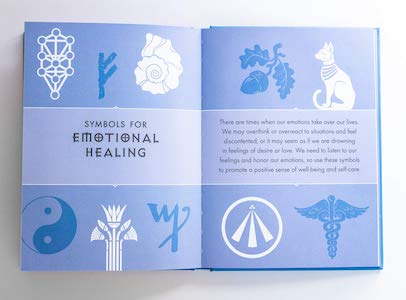
Depending on our culture and beliefs, symbols not only give us meaning in life, but also connect us to the divine nature of the universe.2
Bartlett gives due diligence to the inclusion of a variety of fifty symbols that span diverse spiritual practices and cultures. This holds in keeping with the understanding that no one culture claims the “one” symbol that is the key to the universe. Instead, it presupposes that all symbols are inherently divine and connected in a universal way that may be tapped into regardless of religion or spiritual persuasion. I believe this is an important realization in cultivating a more unified approach to our magical and spiritual workings — inclusion, power, and strength in your beliefs that have been formed by many beliefs.
Sacred Symbol Magic is separated into six sections, including the Introduction, with each section containing those symbols relating to a specific type of energy the practitioner wishes to work with. These include: Blessing the Home, Self-Empowerment, Spiritual Growth, Joyful Relating and Emotional Healing. The topics themselves leave an open-ended feel making them all the more flexible in the specificity of their use beyond the obvious suggestions. This makes the book very user-friendly from the get-go without having to wade through various symbols and then back track to find exactly what you are looking for.
Each symbol is presented with information relevant to its cultural/spiritual origins, keywords, related symbols and a simple how to use. The image of the symbol is beautifully and carefully illustrated in a size that could easily be photocopied and pasted onto a flashcard or altar object and used as a contemplative focus or sigil. A suggestion for magical use/ritual is included with each symbol as well, giving the reader immediate application and trial.
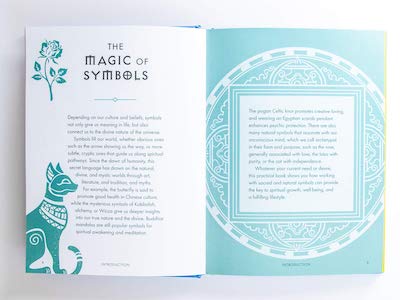
Although the intention of Sacred Symbol Magic was not one of guiding the reader in the creation of sigils, there is enough inspiration contained between its covers to pique the interest in those who are so inclined. One of the basic premises of sigil creation is that of being familiar with the components of the sigil desired that its construction allows for energy to flow through it and the visual product stimulates within the practitioner growth. Incorporating and overlaying some of these symbols in a specific way, and having the benefits of the information provided by Bartlettt would definitely serve the purpose of creation of personal symbols, sigils or talisman.
I was particularly interested in the section containing symbols for spiritual growth…
…. In times of uncertainty, loss, or a change in lifestyle, we all need a belief system or some form of spiritual guidance to know that we are not alone. To access the spiritual power deep within yourself, or to connect to the universe, use these symbols to set you on a positive pathway for your quest.3
Perhaps I was drawn to this chapter given the challenges we have all been facing these past years and months. Regardless, we could all use self-empowerment and a bolster to our goals of spiritual merit. Many of the symbols included in this section would be easily recognizable to most: the all-seeing eye, the pentagram, bee, labyrinth, lotus, om, and more. These affirm the power of symbols in mainstream society and the meanings that are derived in their use, mundane and magical alike.
Sacred Symbol Magic concludes with its last symbol, that of a cat. Perhaps happenstance or intention, I thought it a wonderful symbol of selection as the closure for a journey through the myriad of visual magic.
Cats have long been the harbingers of mystery, power, mischief and those of nine lives who could overcome untimely death. They are walkers between the worlds and familiars who guard, ward and teach. They have been worshipped, maligned, treasured, and feared. Much like the many interpretations for the symbols contained in this title. Each has had its fair share of glory and grief throughout history and all are subject to personal and collective interpretation.
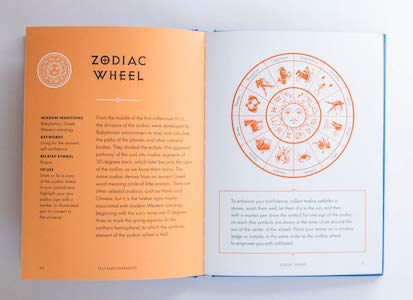
KEYWORDS: Self-esteem, independence, confidence…4
Sacred Symbol Magic brings to light and life the power of symbols and their application to a sustainable and growth-filled magical and spiritual practice. The subtle reminder is that magic is all around us in what we see and what we allow ourselves to explore more deeply in its hidden meanings. The overt intention of one of cultivating and integrating the many paths and the power held in their imagery to connect and unite us at a deeper level. I will be enjoying this book for years to come.

Robin Fennelly is an Elder within the Assembly of the Sacred Wheel Tradition [www.sacredwheel.org]. She is a dancer, teacher, astrologer, author, ritualist and seeker of all things of a spiritual nature. Her writings and classes incorporate a deep understanding of Eastern practice and Western Hermetics and bring a unique perspective towards integration and synthesis of the Divine and Mundane natures of our being. She is a mother of five and lives in Eastern PA with her husband of 45+ years.


